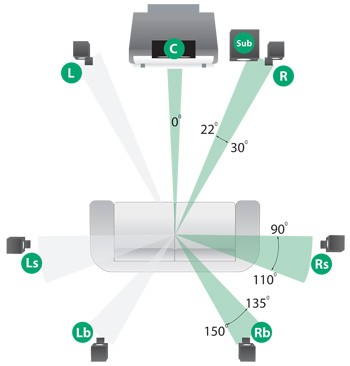Building a killer home theater includes more than just throwing a significant wad of cash at your local electronics dealer. It demands preparing, finesse, and scientific acoustic manipulation. There are a lot of strategies and technologies used in today's major home theatre systems. Here's how to setup like a pro.
A good way to develop the ultimate home theater system, not surprisingly, is to fill the space with a quality system. If you can afford to do that, amazing. But you nonetheless have to employ a set of design methods to assure that the gear performs it it's peak capability. The following guidance applies whether your sound-blasting spending budget makes it possible for only a couple hundred or as a big deal as quite a few thousand dollars.
The Seat:
What you sit on is just as important as where you happen to be sitting. Here are some things to hold in mind when picking furnishings for your house theater.
Keep chairs clear. Seats with higher backs can block the audio coming from your surround sound speakers, compromising the experience. Shorter furnishings clear the path to the speakers.
Help your spine. This is about minimizing distractions. If you're back is stiff and your coccyx is numb, you are not going to really feel that bass rattling your can.
Get off the wall. Positioning seats right next to the walls interrupts the path sound travels in most rooms.
The Space:
Before you commence shoving seats and speakers in an open space, stop for a minute and look at the room. The acoustic chamber contributes about half of the possible sound quality and presentation. Envision your layout strategically.
Keep the area quiet. Remove sources of distracting background noises. Shut the door!
Handle the light. Relocate distracting lights or reflections. Placing the Television opposite a window that faces the sun will result in a glare. Use lights that can be dimmed for ideal viewing. Close the shades. The area doesn't require complete darkness, just dimmed some.
Get rid of visual distractions. Keep away from vibrant reflective surfaces close to the screen. This is especially critical with a 3D Tv. But 3D or not, peripheral visual distractions pull you out of what is supposed to be an immersive experience.
Stay centered. Make sure the room makes it possible for the center channel to be placed in the heart of the layout. This is the source of most of a film's dialogue.
Do not overdo dampening. You do not will need to run out and purchase acoustic treatment. Most living spaces with bookshelves, photos, furniture, and drapes absorb and reflect sound in a way that is fine for most people today. Never program in a completely empty space, as it can act as an echo chamber.
The Picture:
Shop for the right Television to fit your room. You want a screen that's big and adequate to be enveloping, and modest enough to be sharp and clear.
Check the size. What size screen need to you get? You want a horizontal viewing angle of 40-degrees from your seats. There's an actual formula that helps you figure this out. Measure the distance of the screen to the principal seat, in inches. Multiply that by .84 and you are going to get a diagonal screen size (Distance x .84 = Screen Size). This a maximum screen size recommendation.
If your seat is 72 inches from the screen, the formula would look like this: 72 x .84 = 60.4. So the maximum recommended screen is 60 inches. Of course, you can go bigger. It is definitely up to you. Just make sure that you don't have to move your head back and forth to keep up with the action on screen.

Find a deal. Technology changes quickly, so it is hard to say what will be the greatest form of HDTV from day to day. If you can afford the best, get it. But, get the ideal TV obtainable in your price tag range at the time.
The Sound:
That rumbling crescendo at the starting of a THX-certified film in a public theater, known as the Deep Note, emphasizes the importance of the system's speakers.
Seek uniform delivery. You want a sound coverage pattern, recognized as off-axis overall performance, that equally envelops everybody in the room.
Test the placement. The center channel is the largest challenge to a sound system and the most crucial speaker in the room. Low quality speakers are prone to lobbing, a degradation of sound triggered when speakers of the very same size and shape are placed too close together. This degradation causes each seat to get a different sound. But there is a test to make sure the speaker array provides the same sound to every viewer: pink noise.
Pink noise is a test signal. It really is a shushing sound that has the similar power at all octaves. You can download iOS and Android apps that feed pink noise to the system. Pump up the pink noise and walk about your theater space. You'll hear the sound adjust as you move. You want to check that the sound that is broadcast to all of your seating sounds similar. Adjust the room's configuration until you are accurately aiming all the speakers at your audience.
Come across the center. The center channel is fine under the screen. It's much better above the screen. It really is at its finest when it is behind or within the screen—that works if you are using a projection technique with a screen that makes it possible for sounds to pass through without muffling them.
Position the surround. Surround sound speakers need to be to the side, above, and perhaps a bit behind the audience. Do not aim the speakers directly at the listener's' ears. The surround sound speakers should really have a left and right spread of 45 to 60 degrees. If feasible, get high dispersion speakers, which spread the sound as it comes out of the speakers.
Match the mouths. Forward left and right speakers must be 5/8 of the way up the Tv screen. This aligns the speakers with the actors' heads on the screen, producing the feeling that the sound is coming from their mouths.
Pump the bass. The purpose of the subwoofer is to have it play all the sounds at frequencies of 80Hz and below. (Verify your unique hardware's guidelines for setup procedures.) Keep the subwoofer away from walls. The quality of the bass will improve and your neighbors will thank you.
The Electronics:
To connect the Tv and speakers with each other, you want a configuration that is higher in top quality and low in complexity.
Match the receiver to the space. It is essential that your receiver is acceptable for its environment. An overpowered receiver in a tiny room is just a waste of dollars. This doesn't mean sacrificing quality. A high end system has noticeably better sound quality than cheaper knockoffs. It's better to buy higher quality than bigger system size. Scale down the deafening stadium level output and choose better quality for the same price.

Make it plain. If you have five remotes on the table, you are doing it wrong. The goal is to operate the theatre system applying a single remote that the least tech-savvy individual in the home can operate.
Get the appropriate gear. Initial, cover the fundamentals. Does the receiver you happen to be thinking about have adequate inputs for all of your peripherals? There is no shame in purchasing equipment from a dealer that will support your set up and show you how to use it. If the equipment's manual is larger than the last book you studied, get support.
Conclusion:
The equipment you choose is as important as how you set it up.Go for the best you can get but set a budget. Do what works for you and your household. I hope this guide helped you and have an awesome time with your home theater system!







































